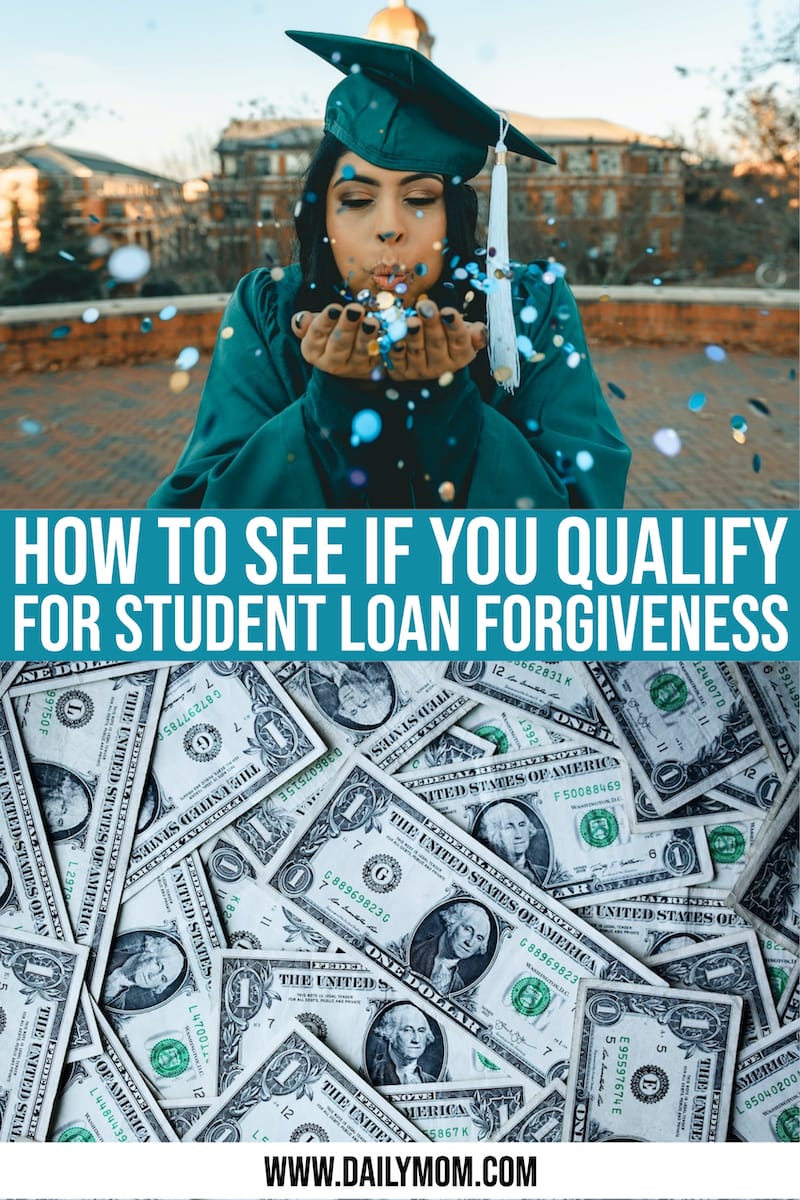Attending college can come with a hefty price tag. Tuition varies widely based on a number of factors, including public or private, in-state or out-of-state and two-year or four-year schools. And let’s not forget the costs of room and board, transportation and textbooks. It’s no wonder that when leaving with their diploma, many college graduates take with them massive amounts of debt—and later find themselves searching for student loan forgiveness.

Just The Basics, For Student Loan Forgiveness Beginners
Outstanding student loan debt hit the $1.6 trillion mark in the United States in 2020 and was owed by nearly 45 million borrowers, according to EducationData.org. But what happens when life doesn’t go as planned and you find yourself unable to pay back your loans? The good news is, in certain cases, you may qualify for student loan forgiveness.
That’s right, in specific situations, you can apply to have your federal student loans forgiven, canceled, or discharged—meaning that you receive permission to stop paying on your student loans—for good! As you might expect, there is a long waiting period, lengthy process and many criteria and hoops to jump through (which we’ll get to shortly), but if you qualify and are willing to undertake the steps, your patience could pay off.
Understanding The Terms
When searching for student loan forgiveness information, you’ll see several terms tossed around somewhat interchangeably: forgiveness, cancellation and discharge. They sound similar, and they are; they’re just used in different ways.
When you no longer have to make payments on your student loans because of your qualifying job, that’s forgiveness, or cancellation. Discharge refers to situations where other unique circumstances apply, such as if you become totally and permanently disabled, or if the school where you received your loan actually closes.
We’ll focus on forgiveness, but the Additional Programs section contains further information, including contact info to discuss your personal circumstances with an expert. (Always a smart approach!)
Read More: THE TOP 5 MONEY MISTAKES COLLEGE STUDENTS MAKE

Who Qualifies For Student Loan Forgiveness?
At this point, you may be thinking, “Sounds great. I’d love to stop paying off my student loan debt. Where do I sign up?” Not so fast—only certain loans and situations qualify for student loan forgiveness consideration.
According to StudentAid.gov, an official website of the United States government, these are two main categories, Public Service Loan Forgiveness and Teacher Loan Forgiveness. While both are forms of forgiveness, the qualifying criteria is different, so it’s important to understand this.
Public Service Loan Forgiveness
You may be eligible for student loan forgiveness under the Public Service Loan Forgiveness (PSLF) Program if you are employed by a government or not-for-profit organization. PSLF forgives the remaining balance on your Direct Loans after you have made 120 qualifying monthly payments, under a qualifying repayment plan, while working full-time for a qualifying employer.
- What Types of Loans Are Eligible? PSLF is only available for Direct Loans, but Federal Family Education Loan (FFEL) Program loans and Perkins Loans may become eligible if they are consolidated into the Direct Loan Program.
- How Are Qualifying Payments Calculated? A qualifying monthly payment is a payment you’ve made after Oct. 1, 2007, under a qualified repayment plan, for the full amount of your bill, no less than 15 days after the due date, and while you are employed full-time by a qualifying employer. Miss any one of these criteria and your application could be denied.
- What Are Qualifying Repayment Plans? Only Income-Driven Repayment (IDR) Plans, which are plans where your monthly payment is based on your income, qualify as repayment plans. If you currently have a Standard Repayment Plan, this would need to be converted to an IDR plan before you are eligible for forgiveness. (Important note: If your income has increased, your required payment amount may increase as well. If this is the case and you do not want your monthly payment to go up, the PSLF Program may not be the right fit for you.)
- How Do I Know If My Employer Qualifies? If your employer is a government or non-profit organization, you may qualify for student loan forgiveness. Note that you must be employed full-time. An Employment Certification Form must be filled out for each qualifying employer you’ve worked for. To make the application review process more efficient, you should submit this form annually, or at a minimum, any time you change qualified employers. Otherwise, you’ll need to backtrack and gather lots of extra paperwork from prior employers at application time.
Teacher Loan Forgiveness
If you teach full-time for five complete and consecutive academic years in a low-income elementary school, secondary school, or educational service agency, you may be eligible for Teacher Loan Forgiveness.
- What Types of Loans Are Eligible? This program is available for Direct Loans and FFEL Program loans.
- Who Qualifies? Teachers who teach full-time for five complete and consecutive academic years as a highly qualified teacher in a low-income elementary school, secondary school, or educational service agency are eligible for forgiveness up to $17,500 on Direct Loan or FFEL Program loans.
- How Do I Find Out If My School or Educational Service Agency Qualifies? Your school or agency must be listed in the Teacher Cancellation Low Income (TCLI) Directory that the U.S. Department of Education publishes each year.
Note: You may not receive a benefit for the same qualifying payments or period of service for Teacher Loan Forgiveness and Public Service Loan Forgiveness.
Additional Programs
In addition to the forgiveness programs above, there are other federal loan assistance programs available. These include: Closed School Discharge, Perkins Loan Cancellation and Discharge, Total and Permanent Disability Discharge, Discharge Due to Death, Discharge in Bankruptcy (in rare cases), Borrower Defense to Repayment, False Certification Discharge and Unpaid Refund Discharge. These apply to very specific scenarios, but if you think you may qualify, you can learn more at StudentAid.gov. For more personalized assistance, contact your loan servicer.
Read More: CAREER PLANNING: EVERYTHING YOU NEED TO KNOW

Applying For Student Loan Forgiveness
If you think you may qualify for the Public Service Loan Forgiveness or Teacher Loan Forgiveness Programs, your best move would be to contact your loan servicer to fully understand and begin the process. Here’s what you can expect from there: You’ll fill out an application, submit it to your loan servicer and continue to make payments during your application review period, which can generally take 30-90 days for lender approval.
Keep in mind that this can be a complicated process and may take much longer–even after your lender shares good approval news. Just to be safe, be prepared for the process to drag on past the 90-day mark. Have patience and be sure to document all payments and any correspondence along the way. Also, note that during the application review period, and at the time the loan is actually forgiven, you must be employed by a qualifying employer. So don’t up and switch jobs until the process for student loan forgiveness relief is completely finalized!
Once your application is approved, you’ll be notified that you no longer need to make loan payments. If you qualify for only a portion of your loan, you are responsible for repaying the remaining balance. On the other hand, if your application gets denied, you’ll continue to be responsible for repaying your loan according to its original terms. If you believe there to be an error, a quick conversation with your loan servicer may help provide more clarity.
Resources For Student Loan Forgiveness
Learn More: Public Service Loan Forgiveness (PSLF) | Teacher Loan Forgiveness
Applications and Forms: Form Navigator | PSLF Application | PSLF Employment Certification Form | Teacher Loan Forgiveness Application

Other Considerations For Student Loan Forgiveness
As you embark on this arduous search for student loan forgiveness, keep in mind that nothing worth having comes easy. You must follow each qualifying factor to a tee, or you’ll risk your application being denied. Ensure that you have the right type of loans, correct repayment plan, and a qualifying employer (plus employment verification), before you start. Checking and double-checking again could prevent many headaches down the road. You definitely don’t want to be the next student loan horror story that has to learn a lesson the hard way.
Alternatively, you should evaluate if forgiveness is the right path to take at all. What if something significantly changes with the program in the next 10 years, and it goes away before you are even eligible to apply? Had you been paying more toward your monthly loan payment instead of banking on forgiveness and just paying the minimum, your debt may have been paid off well ahead of schedule. Refinancing for a lower rate may be another option, but going that route will make you ineligible for federal forgiveness and income-driven repayment programs entirely, so make that choice wisely.
Finally, while exploring your forgiveness options, it may make sense to consider state-run loan repayment assistance programs (LRAPs). These can offer rewards sooner than federal programs, and are often geared to other professions such as doctors, lawyers, nurses, and other qualifying professionals. Money can often be used for private loans as well, and this process often moves faster than federal programs. Learn more about available LRAPs.
COVID-19 Impacts To Loan Forgiveness Programs
In recent months, two stimulus bills have been introduced to help provide debt relief to Americans during these trying times. There are impacts for student loan forgiveness in both:
- Why care about the CARES Act? The Coronavirus Aid, Relief, and Economic Security (Cares) Act, passed in March 2020, has temporarily suspended interest, payments and involuntary collection until September 30, 2020 for most federal student loans.
- What are the quick facts on the HEROES Act? The Heroes Act (if passed) will extend CARES debt relief to September 30, 2021 and also provide up to $10,000 in debt forgiveness for federal and private loans for economically distressed student loan borrowers.
In the unprecedented times we now live in, we’ll be watching these current events closely to see how it all unfolds.
Determining whether you should apply for student loan forgiveness is not something you should take lightly. After careful consideration, a review of the criteria and your eligibility, discussions with your loan servicer and consulting with your financial professional, you’ll be better positioned and armed with the right resources to make this decision.
Remember, each situation is different, so your path may unfold differently than described above. Hopefully though, our overview and links to expert resources have helped take some of the uncertainly out of the process and given you a better idea of what you can expect. Best of luck!
WANT TO READ MORE?
Looking for more ways to save? Check out these 5 Helpful Tips for Budgeting This Year.
💖 NEWSLETTER: DAILY READS IN YOUR INBOX 💖
Sign up to receive our picks for the best things to do, see and buy so you can relax and focus on more important tasks! Let us help you be the best version of yourself you can be!
GET MORE FROM DAILY MOM, PARENTS PORTAL
Newsletter: Daily Mom delivered to you
Facebook: @DailyMomOfficial
Instagram: @DailyMomOfficial | @DailyMomTravel | @BestProductsClub
YouTube: @DailyMomVideos
Pinterest: @DailyMomOfficial
📌 LOVE IT? PIN IT!📌

Photos by Unsplash










































